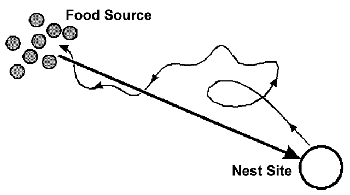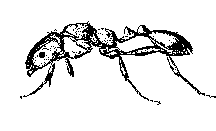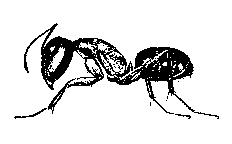Ant Trails: A Key to Control with Baits
Introduction
Communication in the ants is based on chemical signals. These chemicals are called pheromones and vary from alarm and nestmate recognition, to the one we will focus on here, recruitment. All of the pest ants use odor trails for orientation, but these trails differ from one species to another. Where the pheromones originate in the ant's body, their chemical composition, as well as how long they last, all vary from one ant species to the next. In fire ants, the trail chemical is produced by the Dufour's gland, which is named after its discoverer, Dufour, and is laid down by the stinger. This pheromone is made up of molecules which evaporate very quickly. Thus, the odor trails of fire ants are very short-lived. In comparison, the trail pheromones of some carpenter ant species, which are produced by the hind gut, will last for days. However, in both cases, these odor trails have the same purpose of communication, namely recruitment to a resource.
Trailing
A scout ant in search of food leaves the nest and, in the random search pattern that follows, takes a somewhat meandering path outward, until she finds food. She then feeds on the food source and heads straight back to the nest. Somehow on the outgoing trip she can keep track of her position with respect to her nest, and, on the return trip, uses this information to take the shorter, more direct route home. On the way back to the nest, she lays down an odor trail. Once back in the nest, this scout ant then alerts her nestmates of the food find, which encourages them to leave the nest. These recruited ants will follow the odor trail directly to the food source. In turn, each ant will reinforce the odor trail until the food is gone. This behavior is a highly efficient means of exploiting a temporary food resource.
 |
In some instances, these odor trails can become more or less permanent, as in the case of ants that are visiting permanent food sources such as an aphid colony, garbage area, and other sites in structures with permanent food and water. The trail can even be physically cut into the turf, as with carpenter ants that chew their way through the thatch layer.
Structural guidelines are another type of trail that ants use to orient themselves in their natural environment. These may include twigs and branches which ants use to travel to and from the nest on foraging trips. Traveling along a branch lying on the forest floor is much quicker than negotiating a path through grass or leaf litter. In the man-made structural environment, guidelines consist of pipes, conduits, wires and other utility lines. Ants follow these guidelines to enter structures as well as to travel within them. These structural guidelines serve as natural highways for ants.
Trailing along these chemical or structural guidelines is an important behavior of ants that, if better understood, can be exploited for control purposes. In inspections, trailing ants should be observed carefully to determine where they are getting into structures. Through close observation, the source of the infestation can be located. Following trailing ants is the best way to locate the actual nest site. One can feed wandering ants a little honey or pieces of insects and then follow them directly back to their nest site.
In the two examples which follow, this behavioral knowledge will be applied to the control of Pharaoh ants in an apartment complex, and carpenter ants in a home.
Pharaoh Ants
Perhaps never is it more critical to consider trailing behavior than in baiting programs for Pharaoh ants. Baits cannot be placed in just any location and be expected to work. Pharaoh ant trails and their resources (both food and water) must be located for proper placement of baits and effective control.
An interview with each apartment dweller is a good way to begin to locate areas of ant activity, and to educate the resident on the control program. It is important for the resident to understand that it will take time for the bait to eliminate the ant problem. The resident should understand that delayed-action baits take time to accumulate a toxic dose in the ant colony, so that the entire colony can be eliminated. Sprays may be used several days later after baits are applied to kill off any stragglers. However, sprays should be avoided initially as they will only cause satelliting (formation of new nests), will kill only a few foragers, and might contaminate bait stations.
A pretreatment survey should be conducted first using dabs of peanut butter on a white index cards. Then place the cards in food and water locations throughout the apartment complex as well as outside. Inside, survey cards should be placed in the apartments, and other areas such as the lobby, kitchens, laundries, lounge areas and offices. At least eight to sixteen cards should be placed in each apartment (usually two to four each in the kitchen, living room, bathroom, and bedroom). Survey cards should be placed in any areas where the resident has seen ant activity.
Window sills should be used for card locations in the living room and bedroom of each apartment. Dead insects on window sills attract foraging ants, and the numerous cracks and crevices around window casings are ideal nest sites. In the kitchen and bathroom, cards should be placed near sources of water, such as pipes and drains, sinks, counter tops, and toilets. Outside, survey cards should be placed near windows, around entrances and exits, and incoming and outgoing plumbing lines. It's important to position the cards along edges or other structural guidelines, where the ants are likely to travel. These cards should be left undisturbed for several hours, and then the number of worker ants on each card should then be estimated and recorded on an inspection diagram.
This pretreatment survey locates areas where ant activity is concentrated, so that baits are placed in areas of greatest ant activity. Monitoring will find small isolated colonies that otherwise might be overlooked and could cause reinfestation in the future. Where feeding occurs at survey cards, the trailing ants should be traced back to where they are entering from a crack or crevice, switch plate, pipe flange, etc. These entrance sites should be noted on the diagram, and the toxic baits placed here in the treatment program.
A good floor plan of an infested apartment complex can be used as the inspection diagram to document survey data and locate bait treatments. Not only is this an invaluable tool, but it can also be used to educate the resident about the ants and discuss treatment strategy. A floor plan will help in estimating how much bait or how many bait stations to use. For an average size room, four to six bait stations (depending on the level of infestation), should be sufficient. A large apartment complex with a heavy infestation of Pharaoh ants will require more bait and application time, as well as the potential for a higher frequency of reinfestation compared to a small apartment complex with a light, localized infestation.
 |
Carpenter Ants
Many of the techniques used for baiting Pharaoh ants will come in handy when baits become available for carpenter ants. Until that time, however, carpenter ant control will rely on spot and barrier treatments with residual insecticides. How can knowledge of trailing behavior be applied to these methods of control?
In carpenter ant control, probably more so than with most other ant problems, the pretreatment inspection survey is the single most important component of a successful control program. This is because the nest site is very often extremely difficult to find. Here, again, the use of structural guidelines by carpenter ants should be emphasized for inspections. In cases where control measures have failed it may be helpful to conduct a night inspection, since carpenter ants are nocturnal. Just as in Pharaoh ants, a pretreatment survey (using insects or honey instead of peanut butter) may also help in determining areas of ant activity.
The treatment should be focused on areas where ants travel, such as behind pipe flanges and switch boxes where the ants travel along pipes or wires in wall voids. For treatment inside structures use dusts applied lightly to avoid repellency which occurs when too much dust is present. The ants must walk through the dust and pick it up, not walk around it.
On the outside perimeter, liquid sprays are applied in a band that is thoroughly and judiciously placed to prevent ants from trailing into a structure. If this is not carefully done to provide a continuous barrier, ants will find a break or bridge to cross over and infest our structures.
Besides these important chemical control procedures, there are several nonchemical techniques which can be used to help out. Trimming back vegetation that may provide runways for the ants onto the structure, and sealing or caulking entryways into a structure.
In dealing with ants always keep one step ahead of their trails, whether during inspections to determine how they are getting into the structure and where they are traveling within a structure, or during treatment focusing on those areas where ants are likely to travel. Incorporating these ideas on trailing behavior into ant control programs will insure more effective inspections and more successful treatments, and allows for better control while minimizing the use of chemical pesticides.
 |
Baiting
Like all living organisms, ants have certain nutritional requirements: carbohydrates, proteins, and fats. In nature they obtain these essential nutrients from a varied diet of insect prey (proteins and fats), nectar, aphid honeydew and other plant products (carbohydrates). These nutrients are found either in liquid or solid form. Ants naturally strive for a balanced diet to optimize the growth of the colony. However, the amount of each of these three dietary requirements necessary for optimal growth may vary seasonally. For example, "bait switching" is well documented in Pharaoh ants which have satisfied their appetite for one food and then consequently, they choose another. Carpenter ants eat a diet rich in proteins (for example: mealworms) during brood development, usually in the spring and summer, but the colony will change to carbohydrate (for example: honey) foraging in late summer and fall to meet the adult worker's increased energy requirements (for example: mealworms).
As structural pests, the opportunity for ants to achieve a balanced diet is limited only by sanitation practices and the baits used to control them. Ideally, sanitation problems can be corrected, so that baits don't have to compete with other food items, thus forcing the ants to feed on whichever bait is provided.
Although ant baits have a long history in pest control, there is renewed interest in their formulation and development. This new popularity of baits is most likely due to several factors, including public pressure to reduce pesticide use, current availability of insecticides ideal for baiting ants and numerous advantages which baits offer the pest control industry. Baits are more target-specific than traditional techniques of ant control which have relied on broadcast applications of insecticides in spot and perimeter treatments, placing heavy loads of broad-spectrum insecticides into the environment. Baits are more cost-effective compared to more labor intensive inspections to locate nests (attempts which are often unsuccessful) and to treatment strategies which often involve invasive techniques like drilling and dusting. And, if baits are used properly they are highly effective. For example they exploit the natural foraging behavior of ants to recruit and share resources, thereby spreading the bait toxicant throughout the entire colony, and eventually destroying it.
On the negative side, baits tend to be slower acting than sprays or dusts, requiring patience by a distraught resident, for example, who needs to be educated on how baits work and the length of time required to gain control. Also, their shelf-life is limited due to susceptibility of the attractive part of the bait to spoilage. However, the many advantages of baits far outweigh these two disadvantages, which can be alleviated through education of the resident and new and improved bait formulation.
A bait consists of four components: (1) an attractant, usually a food or pheromone which makes the bait acceptable and readily picked up, (2) a palatable carrier, which gives the physical structure or matrix to the bait, (3) a toxicant, which should be non-repellent, and delayed in action, effective over at least a ten-fold dosage range, and (4) other materials added for reasons of formulation, such as emulsifiers, preservatives, waterproofing or antimicrobial agents. Each of these components must be developed and tested for efficacy. Currently, a variety of baits can be selected, whose efficacy range from marginal to excellent in control.
So, how does one deal with this bewildering array of baits? The best test of a bait is how it works in the field. If the ants are attracted to the bait and are feeding, there's a good chance of eliminating the problem. However, this only holds true if the bait contains a toxicant that is slow-acting. Fast-acting insecticides are only going to kill foraging ants, allowing the queen, nest workers, and brood to survive and soon replace those few that are killed before sharing the poison with their nest mates. Slow-acting insecticides allow time for the foragers to exchange food, eventually eliminating the entire nest when the toxicants reach lethal levels.
If the ants are not visiting the bait, then change to another brand. This is usually sufficient to initiate feeding again. Of course none of these techniques will succeed without thorough pre-baiting surveys, and the sufficient number and proper placement of bait stations.
Authors:
Dr. John Klotz - University of California
Dr. David Williams - USDA, ARS
Dr. Byron Reid - American Cyanimid
Dr. Karen Vail - University of Tennessee
Dr. Philip Koehler - University of Florida
Photos: University of Florida
